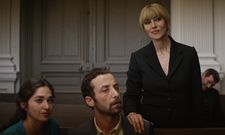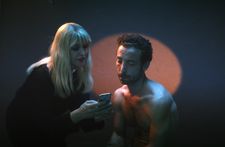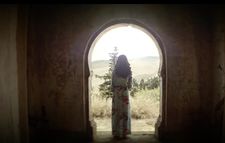 |
| The Man Who Sold His Skin director Kaouther Ben Hania with Anne-Katrin Titze: “I’m happy that you make reference to Shirin Neshat.” Photo: Anne-Katrin Titze |
In the final installment of my conversations from Paris and Los Angeles with Kaouther Ben Hania, the director of Beauty And The Dogs and this year’s Oscar-nominated Best International Feature The Man Who Sold His Skin, the influence of Wim Delvoye, casting Koen De Bouw for Jeffrey Godefroy, working with Patrick Albenque as Mr. Waltz and Stacy DeVorzon as his wife, Shirin Neshat, and the wisdom of the natural world are discussed.
 |
| Abeer (Dea Liane), Sam (Yahya Manayni), Soraya (Monica Bellucci) and Jeffrey Godefroy (Koen De Bouw) Photo: courtesy of Tanit Films |
Sam (Yahya Mahayni), a Syrian refugee, agrees to become a living canvas because “by transforming him into merchandise, he can travel freely.” His love Abeer (Dea Liane) is recently married, living in Brussels, and having a Schengen visa tattooed on his back seems to be the only way for Sam to reach her. Famously provocative artist, Jeffrey Godefroy (Koen De Bouw), came up with the idea, and aided by his gallerist Soraya (Monica Bellucci), they embark on this most mephistophelean of artworks. Sam’s is not the only deal with the devil in this scathing, funny, and punctilious depiction of our divided world.
Anne-Katrin Titze: The artist Wim Delvoye, who has a cameo, was obviously one of the inspirations for the film. You include his pigs, which I always found very very disturbing as an idea and a work. How did the art world inspire all of this?
Kaouther Ben Hania: I visited his retrospective in the Louvre Museum many years ago and I found his tattooed man sitting shirtless, like my character in the movie, in Napoleon’s Apartment in the Louvre, and I found it very weird. You know, when you have something disturbing at first sight, then you take the time and ask yourself the why and the how, you find the question very interesting in general. Starting the project of a movie is always a very enigmatic operation because you are hit by an image or a character or a situation, and it stays in your head for months and maybe years and you can’t get rid of it. It’s there, calling other elements, you know, gathering other elements and then it becomes in a way conscious and you start gathering references and thinking about it.
 |
| Sam (Yahya Manayni) Photo: courtesy of Tanit Films |
And then it becomes a story in a conscious way. You ask yourself, who is this guy? Why is he sitting in a museum? What if he was a Syrian refugee? Why he did it, why he can’t get out. This is what is fabulous about my work. You are questioning yourself all the time. You have to bring answers to fabricate something. So yeah, when I started writing, I thought to myself, wait, it’s an inspiration from the work of Wim Delvoye, maybe I have to ask him his permission for rights reasons or, I don’t know, to tell him also that his work inspired me to write this story. So I contacted him, we met in Paris, and he told me “Yeah, go ahead, write your script. I don’t want to be linked too much to this movie. I told him “Okay, no problem.”
AKT: And then you cast him as the insurance man, which is so funny.
KBH: I think in the beginning he was suspicious. Maybe I’m not a serious person, maybe it’s not serious. And then I cast Koen De Bouw, the actor, for the part of Jeffrey Godefroy, who is a big star in Belgium. Koen De Bouw wanted to meet him. So they met and spent all day together, talking for eight hours. Then Wim Delvoye told me “I want to be more present in this project, in this movie.” So I told him “Listen, I have the part of the insurance guy saying this and this.” He said “It is perfect for me. I take it.”
 |
| Jeffrey Godefroy (Koen De Bouw) Photo: courtesy of Tanit Films |
AKT: This scene, with Mr. Christian Waltz and his “lovely wife” in quotation marks, is one of my favorites in the film. It encapsulates a certain sphere of the art world so perfectly. The way the wife behaves connects to the “it” of the human art work he is pointing to during the interview! “This work of art bears the signature of the devil,” they say. Everything is folded into the other. Did you have fun shooting this scene?
KBH: It was very difficult because it was a scene with a lot of extras. In the beginning I wanted to do it in one shot, so I had to choreograph everything. Then in the editing I cut it inside, but I love Mr. and Mrs. Waltz. They were fun to work with and they are great actors. In only one scene they propose all I wanted and when you see them you know exactly what kind of people they are.
AKT: So many associations came to me while watching your movie. In the context of writing on the body, Shirin Neshat’s work came to mind. On the other hand, also Pillow Book by Peter Greenaway. I like that you left room for us to go there. Ultimately it is about justice and that there is none. There is no equality. There’s chance, games of love and chance that are controlling us.
 |
| Soraya (Monica Bellucci) Photo: courtesy of Tanit Films |
KBH: I’m happy that you make reference to Shirin Neshat. I’m fond of her work, I find it really fascinating and beautiful. And I think that this is the power of images. That one image can bring you 1,000 ideas from your memory. It’s like a meeting. That’s why cinema is that powerful a medium. And about justice, that’s a topic that obsessed me almost. My previous movie, Beauty and the Dogs, it was also about a big injustice. And equality which doesn’t exist, as you said. Yeah, I agree almost with everything you said, yes.
AKT: I love the moment when Sam is displaying his back and the little girl is asking if all people from afar have this visa on their back. The guard treats him like an object. But the scene is very hopeful.
KBH: Yeah, children in their naïveté, they can ask the right questions. In a child’s mind seeing this guy with the tattoo and the teacher is talking about an important document. For a child it’s not a natural thing. When you want to travel, to fly, you need a document - there’s wisdom in the child’s gaze, wisdom linked to the natural world. Because the world of adults and politicians and the system globally, it’s a fictional world that has become ingrained. What is a Schengen visa? What is a visa? It’s a convention between people. So I found it interesting to see this moment through the gaze of a child.
 |
| Soraya (Monica Bellucci) with Sam (Yahya Manayni) Photo: courtesy of Tanit Films |
AKT: My last comment is about the framing of the entire film via an arm around a person’s back. The whole love story begins, as far as we get to see it, with Sam’s attempt to put his arm around Abeer’s back. It starts the entire journey. At the very end, you have the arm around the back again.
KBH: Oh my god, I never thought about it.
AKT: Whereas when he is exposed and on display, there is no arm around his back. Nobody has his back. He has to fight for someone to have his back and his back is exposed. I loved how it comes full circle.
KBH: Thank you for telling me this because I never thought about it or noticed it. It was an unconscious thing. It was more because the movie is mainly about freedom. It’s like this guy and this girl also, this guy doesn’t possess his body. Under dictatorship, in public space, he can’t do whatever he wants in a normal way in his body. So his body is the property of dictatorship.
The first mistake he commits, he will go to jail, and then go into this bigger orb, he loses control over his body, he sells his skin. And he goes again to the jail and he is smiling because it’s the beginning of his journey to gain again his body. At the end when we see their backs, we understand that they possess their body, they gained this kind of freedom.
 |
| Abeer (Dea Liane) Photo: courtesy of Tanit Films |
AKT: A very intricate resurrection.
KBH: Thank you so much, bye-bye, ciao.
- Read more on what Kaouther Ben Hania had to say on The Man Who Sold His Skin, Alfred Hitchcock and François Truffaut.
- Read what Kaouther Ben Hania had to say on Beauty And The Dogs.
- Read what Yahya Mahayni told us about getting under the skin of The Man Who Sold His Skin.
- The Man Who Sold His Skin opens in the UK on September 24.





















